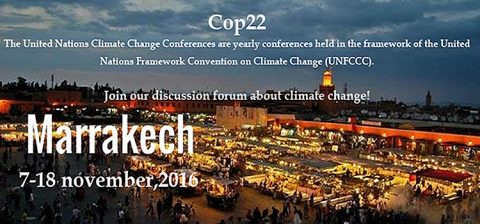
Maandag begint in Marrakech COP22
4 november 2016 – Maandag begint in Marrakech (Marokko) COP22. Het is de eerste bijeenkomst van alle partijen na het Akkoord van Parijs. Het worden vergadersessies met een merkwaardig gemengde stemming: positief vanwege het snelle van kracht worden van ‘Parijs’, negatief vanwege het UNEP-rapport van gisteren dat duidelijk maakt dat ‘Parijs’ bij lange na niet genoeg is.
‘Marrakech must galvanize action’
Uit een vooruitblik van CAN Europe
‘(…) With the Paris Agreement in place, COP22 must ensure the way is paved for transformative action to take place in the coming years. This week, the United Nations Environment Program (UNEP) will launch “The Emissions Gap Report”. This report will reveal the gap between commitments made by countries and the emissions reductions needed to stay below the agreed global average temperature rise. With these numbers fresh in mind, countries must focus on scaling up ambition. Issues such as how to scale up climate action and finance before 2020; how to establish a process for assessing and reviewing countries pledges under the Paris Agreement; and how to scale up support for loss and damage will all be discussed in Marrakech. For these discussions to move swiftly forward, it is important that countries bring concrete plans to the table.
Enhancing action before 2020
Action before the year 2020 is a prerequisite for reaching the long-term goals of the Paris Agreement. In Marrakech discussions on how to undertake radical action in the coming years will be a priority, and the Moroccan presidency of the Conference will seek concrete contributions from all countries. As for the EU, announcing the cancellation of current surplus emission allowances in the Emissions Trading Scheme would be a much welcomed contribution. Since the EU is going to overshoot its 2020 target, cancelling surplus allowances would contribute to steeper emission cuts between now and 2020. Choosing not to do so would mean that the EU can make use of the surplus allowances to fulfil its post 2020 action, which means that actual reductions will not be as great.
Discussions about action before 2020 must also give greater priority to how to scale up climate finance, especially with regards to adaptation and loss and damage. Donor countries must at COP22 provide greater clarity on how the $100 billion roadmap will guarantee sufficient support for the most vulnerable communities.
Reviewing and scaling up ambition for action after 2020 (NDCs)
The process of how to raise the level of countries’ individual climate pledges under the Paris Agreement (so-called Nationally Determined Contributions, NDCs) must start in Marrakech so that these can be reviewed as soon as possible. At COP22, countries should agree on critical elements of this process so that countries are ready to review their pledges in 2018. (…)’
COP, the supreme decision-making body of the UNFCCC
Uit de website van COP22
‘(…) The COP stands for the “Conference of the Parties.” It is the supreme decision-making body of the United Nations Framework Convention on Climate Change (UNFCCC), opened for signature in 1992 during the Earth Summit in Rio de Janeiro and later entered into force in 1994. Through this instrument, the United Nations has equipped itself with an action framework to fight global warming.
After its entry into force in 1994, the UNFCCC Secretariat was established in Geneva. It was then relocated to Bonn in 1995 following the “First Conference of the Parties” (COP1) in Berlin. Since then, there have been twenty-one COPs, with the most recent one organized in Paris this past December. The next one, COP22 is scheduled to take place in Marrakech, Morocco from November 7 to 18, 2016.
The COP was created and put in place in order to structure the efforts of the Parties to the Convention as they address climate change. The COP meets annually to review and assess the implementation of the UNFCCC and any other legal instruments the body adopts with the goal of reducing greenhouse gas emissions and fighting climate change. These annual UN climate change conferences are commonly referred to as COP.
The main objective of the Framework Convention and its related legal instruments are to stabilize the concentration of greenhouse gases in the atmosphere at a level that would prevent “dangerous anthropogenic interference with the climate system.” The term “anthropogenic” refers to the effects caused by human activity. (…)’
Bronnen
CAN Europe, 2 november 2016: Media advisory ahead of COP22 in Marrakech. What to expect and how to judge the EU’s participation?
Website COP22
Foto: UNFCCC/COP22



